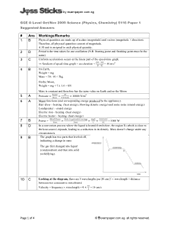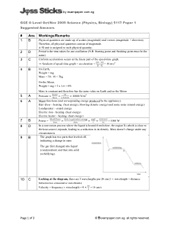OK after a long, long night here are my suggested answers for the Combined Science (Physics, Chemistry) 5116 and (Physics, Biology) 5117 MCQ Paper 1 (along with the usual workings, diagrams and explanations).
Those of you taking other combinations (e.g. Chemistry/Biology 5118) in this ‘O’ Level should probably encounter the same set of 20 Physics or 20 Chemistry or 20 Biology MCQs.


Physics/Chemistry 5116 (left) & Physics/Biology 5117 (right) – click to download
Hope the explanations will clear up some doubts in the argument discussion with your friends on whether it’s “B or C” or “A or B or C or D” (?!) Once again, please leave a comment if you spot any mistake, typo and/or wish to clarify any of the explanations given.
All of you should be rejoicing now in your new-found freedom. Unfortunately not for me though 🙁 *looks over shoulder at my sister*




 Miss Loi is a full-time private tutor in Singapore specializing in O-Level Maths tuition. Her life’s calling is to eradicate the terrifying LMBFH Syndrome off the face of this planet. For over years she has been a savior to countless students …
Miss Loi is a full-time private tutor in Singapore specializing in O-Level Maths tuition. Her life’s calling is to eradicate the terrifying LMBFH Syndrome off the face of this planet. For over years she has been a savior to countless students … 





















14 Comments
曜
日
Physics/Chemistry paper 1 5116 answers cannot be accessed
曜
日
Hi jasper,
That's strange as it looks fine on our side. Which version of Adobe Reader are you using?
Are you able to view other pdf files (like 5117 etc.) on this site? Are you getting an error message like the "the file is damaged and cannot be repaired" which another student has reported earlier?
Any one else having trouble accessing the solutions?
曜
日
Hey Miss Loi, do you have the solutions for pure Biology p1 and pure Chemistry p1 too?
曜
日
Miss loi, i think for chemistry MCQ , the answer for question 36 should be C?
Reason : Crude oil undergo Fractional distillation to seperate the hydrocarbons in it and not cracking.
Please correct me if i am wrong (:
曜
日
ya.. i think is fractional distillation ..
曜
日
Oh thanks Matthewese and Gwen for pointing out Q36, and the answer has been updated.
Yes it should be C as crude oil is first separated into into fractions by fractional distillation. Some of these fractions then undergo a further cracking process to break them down into smaller fractions. This has sometimes been loosely termed as "crude oil cracking" - a term that I errorneously recalled when I did the question 😕
曜
日
GX: OK the Chemistry & Biology Paper 1 solutions are finally up! 😉 And I hope jasper will be able to see them now.
曜
日
hi, can you post de answers for Science Physics and Chemistry Paper 2 and 3 - 2009 O level?
Thanks!
曜
日
Miss Loi, i have a ques regarding Q9.
I thought the questtion says ''until it became a gas'', then how come at the begining it is a gas and not the ending ? cos' you said the gas first changes into a liquid. If the ending is a gas, then why is the answer not C? thanks! (:
曜
日
JS: Errr ... if you read the question again it says
So the scenario was to heat it first to its gaseous state, before being allowed to cool naturally i.e. gas -> condenses into liquid -> liquid -> solidifies into solid -> solid. The graph in the question only captures the cooling process, hence the dropping temperature as time increased.
曜
日
hey miss loi,
question 35 is the iron fillings in a testube with various gases including carbon dioxide and oxygen.
the question stated,''until no further changes in volume.''
I was taught that carbon dioxide will dissolve in water to form carbonic acid.
So shouldn't we deduct the carbon dioxide' volume?
曜
日
Hello soon yang from Shenzhen, where I've just joined my sister (who has been shopping like a mad woman at Dongmen).
For combined science chemistry qn35, the likely purpose of this question is to test our knowledge of what gas is needed for rusting to occur.
While carbon dioxide is indeed soluble in water, do note that this reaction interconverts (i.e. reversible reaction) between CO2 and H2CO3 spontaneously.
CO2 + H2O ⇌ H2CO3
And since we could not determine how much CO2 has dissolved at any one time, we wouldn't take CO2 into consideration.
P.S. even if we were to consider the scenario where ≤ 20 cm3 of CO2 is dissolved, there isn't any suitable option (≥ 50 cm3, < 70 cm3) that has been presented to us by the question.
曜
日
hi miss loi , do you have solutions for 2009 'O' level Principle of accounts p1 & p2 ?
曜
日
science answer cannot access =(